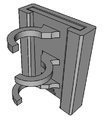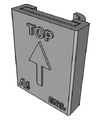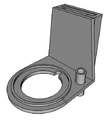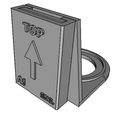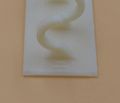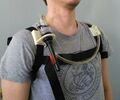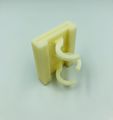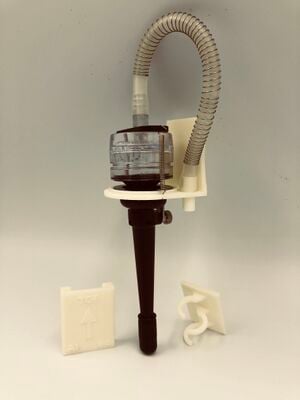
Project

Specialized components are often expensive and hard to find. This project concentrates on these elements such as a way to attach air sampler, hose and a pump to a worker's harness to measure impurities of their breathing zone.
This project was performed as a final project of the L3999 course Spring 2018.
Background
Why measure what workers breath in?
The breathing zone is the area immediately surrounding a worker's nose and mouth (15-25cm). The purpose of air sampling in a worker's breathing zone in the workplace is to ensure that employees are not exposed to dangerous levels of airborne contaminants such as dust, biological agents, or toxic chemicals.
The following two factors are emphasized when exposure is considered:
- level of exposure
- length of exposed time
This is something that is very important in several industries from food industry to mining industry. More safety information can be found here [1]
The need to sample the air that workers breath in leads to the problem of attaching samplers (and also hoses and pumps) to the workers. Worker's differing sizes and also different worn safety equipment can pose challenges for designing one size fit all solution as same equipment is used again and again for different persons. Some bought harnesses can be used, but quite often these too are custom made. Then there is the problem of attaching the measuring equipment to the harness, the solutions for these are custom jobs and on-the-spot solutions such as tape, safety pins and zip-ties.
3D printing offers easy and cheap answer to holding the sampler in place. A picture of the older version of the clip for holding the hose/sampler attached to the harness is presented below. This version was attached to the harness with an adhesive tape. Some versions are attached with screws to the harness, but then these are fixed and can't be moved if the position needs to be fluctuated.
Below here are also two pictures of cyclone sampler, which is attached to the worker's clothing or harness with "grapper teeth". The sampler is relatively heavy and will swing around when worker is moving. This too could use better attachment possibilities.
A picture of an older version of the harness can be seen below. This version is complicated to put on and off in addition of requiring a belt.
Workers keep the sampler/harness on for a normal working day (c. 8h) which means that they should be as non-intrusive as possible. Also ease of use; putting it on and off easily for example, bathroom breaks are very important.
-
Old version of hose/sampler holder.
-
cyclone sampler, hose and air pump.
-
Original cyclone sampler.
-
Original cyclone sampler.
-
Custom-made harness with two different type of samplers.
Project goals
The outcome of the project is a parametric model for universal clip-on for attaching different types of measuring equipment/samplers and their hoses to the harness in proximity of the breathing zone. The clip-on should be adaptable in order to accommodate different harness sizes and equipment. In order to provide proof of concept that the clip-on attachment can also work for other types of equipment, a cyclone sampler holder is redesigned to be equipped with it. As a side project, a new harness design will be tried. The main point of this project is the clip-on design(s), the harness is just meant for the testing and proving of the concept.
Goals can be summarized as:
- Parametric model for universal clip-on
- Concept of remaking cyclone sampler holder compatible with clip-on
- New harness design
Design Decisions
It is important that the sampler, hose and pump are stationary and won't swing around causing dangerous / harmful situations as workers are meant to continue their work normally. The clip-on has to be movable to accommodate correct positioning on the harness.
The clip-on has to be washable as well, as same equipment is used in all kinds of environments.
Several design ideas were drawn, but the challenge was to make a design which would not alter the harness or require any special adaptation (hooks etc.) on the harness.
The design is modeled with respect to two components that are the slider; contains the necessary tooling, in this case, the hose and the cyclone holder, and the clip/sheath; contains the necessary attachment features. The mechanism works in the manner that the slider, when inserted into the clip/sheath provides the necessary forces to hold the harness in between the two components. The stopping mechanism allows for the slider to level with the clip/sheath by clicking and stopping. The release mechanism aids in unlocking the slider and the clip/sheath by providing sufficient amount of friction when a force is applied to it. The respective images and mechanisms of CAD design are presented below.
Two parametric models are created for a cyclone sampler holder using FreeCAD which is a free, open source software that is readily available over the internet. The parametric nature of the models allows for making changes to the model with ease according to the thickness and width of the harness and/or the diameter of the hose(s). The thickness and height of the clip-on itself, and the assembly or print clearances can also be changed easily. These parameters can be seen in the attached images below and can be accessed in the embedded spreadsheet of the models. Please be advised that Boolean operations may fail upon regeneration due to the CAD kernel of the open source software. Use the latest version of the software and try different values of the parametric parameters or delete the Boolean operations to overcome this limitation. Likewise, the fillet operation(s) may fail upon regeneration as well due to the treatment of new geometry by CAD kernel. Remove and redeploy the necessary operation(s) after regeneration to overcome these limitations.
Harness design was very simple and vaguely resembling of a bolero jacket:
- there are two bands, which can be adjusted in the back
- the bands around the armpits can also be adjusted
- the band in front has a locking mechanism
-
First Sketches of the Design.
-
CAD design of clip-on hose holder from front.
-
CAD design of clip-on hose holder from back.
-
Parametric Parameters of the Hose Holder.
-
The stopping mechanism of slider and clip/sheath that clicks upon leveling.
-
The releasing mechanism of slider and clip/sheath.
-
CAD design of cyclone sampler holder from front.
-
CAD design of cyclone sampler holder from back.
-
Parametric Parameters of the Cyclone Sampler holder.
Bill of Materials
1) Universal clip-on (11 mm x 36.51 mm x 50 mm)
2) The cyclone sampler holder (67.38 mm x 55.75 mm x 59.60 mm)
3) The hose holder (25.80 mm x 30.55 mm x 45.00 mm)
3) Harness (30 mm x 1,4 mm x adjustable mm)
Estimated Cost and Manufacturing times
Cost of the original clip-on:
Very difficult to find as it was custom made. After inquiry from experts, the price was decided to be somewhere between 20€ to 30€. The original was an assembly consisting of small plastic part, two cut and bended sheet metal parts and a clamp to attach them together.
Cost of 3D-printed clip-on with increased functionality:
- The amount of ABS filament used in the print =13,049 cm3
- The amount of support material used in the print =4,828 cm3
The time of 3D printing was 2h 44 min.
Price of both ABS and support material is 200€/l. Price of machine time is 4€/h.
Price of clip-on sample holder 200€*17,877/1000 + 164 min*4€/60min= 3,57€ + 10,933€ = 14,5€
Approximate savings per replica: 10.5€
Cost of cyclone sampler holder:
The cyclone sampler holder consists of several parts that are assembled together from which the most critical component for attachment purpose is redesigned. The manufacturer's webpages can be found here [2]. According to Finnish importer the price is 87€+ VAT.
Cost of Clip-on attachment of cyclone sampler holder:
- The amount of ABS filament used in the print =26,649 cm3
- The amount of support material used in the print =9,813 cm3
The time of 3D printing was 4h 13 min.
Price of both ABS and support material is 200€/l. Price of machine time is 4€/h.
Price of cyclone sampler holder part is 200€*36,462/1000 + 254 min*4€/60min= 7,292€ + 16,867€ = 24,16€
Approximate savings per replica (Including 24% VAT on the original and assuming that the attachment component can be sold separately and costs 50% of the total cyclone sampler holder cost): 29.78€
Cost of the original harness:
Old harness was also custom made. The material costs are most probably around 8€ (6m*1,29€ [3], and custom work with cobbler costs c 80€/h. The harness needs around 1-2h of work.
Approximate cost: 128€
Harness cost:
- c. 4,5m of 30 mm Polyene / polypropylene band meant for back-packs and belts a 1,10€/m=4,95€ [4]
- 1 locking system a 1,70€[5]
- 4 adjustment buckles a 70€ = 2,80€ [6]
Altogether 9,45€ + price of sewing the harness together. The time of sewing was less than 30min.
Approximate savings per replica (assuming that price of sewing is the same as cobbler's cost of 80€/h): 78.55€
-
Several clip-on hose holders in printing bed
-
Printed hose holder clip-on with support structures.
-
Printed hose holder clip-on with support structures.
-
Printed hose holder clip-on with support structures.
-
Printed holder of cyclone sampler holder with support structures.
-
Printed holder of cyclone sampler holder with support structures.
-
Printed holder of cyclone sampler holder with support structures.
Directions
Printing
Link to the Model files can be found here [7].
You may print the models with the STL files provided in the above link or here [8] using any ISO/ASTM Standardized Additive Manufacturing Method. The printing materials are recommended to be polymers.
For accessing the parametric models, use the following instructions:
1- Download the model files provided in the Link above or here [9].
2- Download the open source FreeCAD software from here [10].
3- Open the necessary FreeCAD [.FCstd] file using open source FreeCad Software.
4- Double click the spreadsheet to access the parametric parameters.
5- Enter the required Parameters in the provided Spreadsheet (Regeneration may take a while depending on your hardware specs.)'*'
6- Export as STL to print the model.
7- Print the model and remove the support structures (can be removed by hand).
'*'Please be advised that Boolean operations may fail upon regeneration due to the CAD kernel of the open source software. Use the latest version of the software and try different values of the parametric parameters or delete the Boolean operations to overcome this limitation. Likewise, the fillet operation(s) may fail upon regeneration as well due to the treatment of new geometry by CAD kernel. Remove and redeploy the necessary operation(s) after regeneration to overcome these limitations.
Usage
1- Place the Harness in the slot of the clip/sheath through its open side
2- Position the clip/sheath on the harness at correct height and orientation (check the back of the clip/sheath for an arrow pointing to Top, see picture below) where necessary
3- Insert the slider with the release mechanism oriented towards the bottom to the clip/sheath from its Top side
4- Push the slider until it clicks and sinks or levels to the top surface of the clip/sheath
5- Push the release mechanism (represented by segmented arrowhead) upwards to unlock the assembly and to release/separate the components."*"
6- Separate the clip/sheath from the harness
"*"Please do not push the hose holder or any other fragile tooling.
Current Models
The uPrint SE Plus Material Extrusion printer was used to print the models for this study with ivory ABS filament with a minimum layer thickness of 0.254mm. The assembly clearance was also set as 0.254mm. The parts were printed in "upright position" for maximum strength in the X-Y planes as seen above.
The details of the harness design can be seen in pictures below.
-
Printed clip/sheath of cyclone sampler holder from back.
-
Detail of segmented arrowhead
-
Sheath is placed on the harness
-
Sliding the slider in
-
Hose holder clip-on fully placed in the harness
-
New harness with the universal clip-on from front.
-
New harness from back.
Conclusion and Next steps
The project concluded with successful proof of concepts and very well working prototypes. Manufacturing the clip-on(s), sampler holders and harness provided ideas for the future as well as some lessons that were learned in the process. The cyclone sampler holder proved that clip-on design concept can be expanded to other equipment and tools.
For the next step, the clip-on(s), sampler holders and harness are going to go to Työterveyslaitos (Finnish Institute of Occupational Health) to be validated in real life measuring conditions.
Contact Details
Aalto University, Department of Production Engineering
Special thank you to Työterveyslaitos (Finnish Institute of Occupational Health) and especially Anneli Kangas there
== See also ==
Image Gallery
-
Both sampler holder designs in use.
-
Harness from back with a pump attached.
-
Printed and Original holder of cyclone sampler holder.
-
Printed and Original holder of cyclone sampler holder.
-
Printed and Original holder of cyclone sampler holder.
-
Printed holder of cyclone sampler holder with Sheath.
-
Printed and original hose holder clip-on.
-
Printed and original hose holder clip-on.
-
Printed hose holder clip-on.
-
Assembled cyclone sampler with printed holder.
-
Assembled cyclone sampler with printed holder and clip/sheath.
-
Assembled cyclone sampler with printed holder and clip/sheath.
-
Assembled cyclone sampler with printed holder and clip/sheath.






